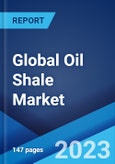The global oil shale market size reached US$ 3.3 Billion in 2022. Looking forward, the market is expected to reach US$ 5.2 Billion by 2028, exhibiting a growth rate (CAGR) of 7.87% during 2022-2028.
Oil shale is a sedimentary rock containing large amounts of fossil organic matter, known as kerogen. It is used to obtain liquid shale oil, which is further employed in the production of fuel oil, including gasoline, diesel, natural gas, and liquid petroleum gas (LPG), and other hydrocarbons using advanced processing methods. Its by-products can also be utilized to produce commercial products, such as ammonia, sulfur, alumina, soda ash, and nahcolite. At present, spent oil shale finds extensive application in cement production around the world.
Oil shale is a sedimentary rock containing large amounts of fossil organic matter, known as kerogen. It is used to obtain liquid shale oil, which is further employed in the production of fuel oil, including gasoline, diesel, natural gas, and liquid petroleum gas (LPG), and other hydrocarbons using advanced processing methods. Its by-products can also be utilized to produce commercial products, such as ammonia, sulfur, alumina, soda ash, and nahcolite. At present, spent oil shale finds extensive application in cement production around the world.
Oil Shale Market Trends
Inflating crude oil prices and the cost benefits of using oil shale over conventional energy resources act as major factors shifting consumer preferences towards oil shale. The market is also influenced by boosting sales of vehicles on account of increasing income levels and rapid urbanization. Moreover, the growing electricity consumption and the construction of new power plants are catalyzing the demand for shale oil worldwide, which, in turn, is strengthening the market growth. Shale oil can be fired in a furnace as a boiler fuel to produce steam for power generation. Furthermore, a significant increase in construction activities across the globe is escalating the demand for cement and other products, which, in turn, is driving the market. Apart from this, advancements in drilling techniques and the advent of innovative technologies of mining and retorting are assisting in reducing the overall operating costs. This, in confluence with the development of new in situ methods for shale oil extraction and the rising use of geospatial infrastructure for managing large volumes of oil shale data, is anticipated to impel the growth of the overall market.Key Market Segmentation
This research provides an analysis of the key trends in each sub-segment of the global oil shale market report, along with forecasts at the global, regional and country level from 2023-2028. The report has categorized the market based on product, process, technology and application.Breakup by Product:
- Shale Gasoline
- Shale Diesel
- Kerosene
- Heavy Oil
Breakup by Process:
- Oil Shale Exploration
- Ore Preparation
- Oil Shale Retortion
- Shale Oil Refining
Breakup by Technology:
- In-situ
- Ex-situ
Breakup by Application:
- Electricity
- Fuel
- Cement and Chemicals
Breakup by Region:
- North America
- United States
- Canada
- Asia-Pacific
- China
- Japan
- India
- South Korea
- Australia
- Indonesia
- Europe
- Germany
- France
- United Kingdom
- Italy
- Spain
- Russia
- Latin America
- Brazil
- Mexico
- Middle East and Africa
Competitive Landscape
The competitive landscape of the industry has also been examined along with the profiles of the key players being American Resources Inc., AuraSource Inc., BP p.l.c., Chevron Corporation, Eesti Energia AS, Exxon Mobil Corporation, Independent Energy Partners Inc., Japan Oil, Gas and Metals National Corporation, Queensland Energy Resources and Royal Dutch Shell plc.Key Questions Answered in This Report:
- How has the global oil shale market performed so far and how will it perform in the coming years?
- What has been the impact of COVID-19 on the global oil shale market?
- What are the key regional markets?
- What is the breakup of the market based on the product?
- What is the breakup of the market based on the process?
- What is the breakup of the market based on the technology?
- What is the breakup of the market based on the application?
- What are the various stages in the value chain of the industry?
- What are the key driving factors and challenges in the industry?
- What is the structure of the global oil shale market and who are the key players?
- What is the degree of competition in the industry?
Table of Contents
1 Preface3 Executive Summary12 Value Chain Analysis14 Price Analysis
2 Scope and Methodology
4 Introduction
5 Global Oil Shale Market
6 Market Breakup by Product
7 Market Breakup by Process
8 Market Breakup by Technology
9 Market Breakup by Application
10 Market Breakup by Region
11 SWOT Analysis
13 Porters Five Forces Analysis
15 Competitive Landscape
Companies Mentioned
- American Resources Inc.
- AuraSource Inc.
- BP p.l.c.
- Chevron Corporation
- Eesti Energia AS
- Exxon Mobil Corporation
- Independent Energy Partners Inc.
- Japan Oil
- Gas and Metals National Corporation
- Queensland Energy Resources
- Royal Dutch Shell plc
Methodology

LOADING...
Table Information
| Report Attribute | Details |
|---|---|
| No. of Pages | 147 |
| Published | November 2023 |
| Forecast Period | 2022 - 2028 |
| Estimated Market Value ( USD | $ 3.3 Billion |
| Forecasted Market Value ( USD | $ 5.2 Billion |
| Compound Annual Growth Rate | 7.9% |
| Regions Covered | Global |
| No. of Companies Mentioned | 11 |









